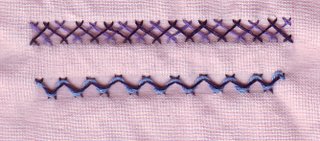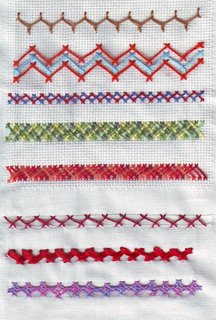Here is my next installment of Herring Bone Stitches.

As you can see, I have not worked the stitches in any particular order.
1. The first one is the Double Herring Bone Method-I. Here one row of Herring Bone stitches is simply superimposed over a previously worked row.
I feel the stitch looks more complete if it is started and finished as shown in this sampler.
2.The second one is the Basic Herring Bone stitch laced with a contrast thread.

Click on picture to Enlarge.
3. I've always wondered if the Cretan stitch is a kind of Herring Bone Stitch. It certainly looks like one.
4. The stacked Herring Bone Stitch - nothing special there but for the effect.
5. The Double Herring Bone Stitch - Method-II. The difference between this and Method-I is the second set of Herring bone Stitches is interwoven with the previous one.
6. I loved the 4 rows of closely spaced H.B.S in Sharon's sampler and wanted to try it out. However having just worked the interwoven Double H.B, I got side-tracked. After a few initial glitches, this stitch was fun to do.
I used three strands of stranded cotten for working the 1st and 3rd rows and 6 strands for working the 2nd and fourth rows. It has a lacy effect.
7. Four rows of H.B stitches superimposed as in Sharon's sampler.
8. I used 6 strands of metallic thread to couch this ribbon. In the process I learnt a valuable lesson. Trying to pull 6 strands of metallic thread through closely woven fabric damages both the fabric and the thread.
9. The basic H.B done with silk ribbon.
10. The Double H.B-M-II is the foundation for this interlacing stitch. This stitch is frequently used in Kutch work - an Ethnic Indian Embroidery and also in Armenian Embroidery.
There are a few more variations I'd like to try out. If time permits, I'll do it today. Otherwise, I'll post pictures as soon as i complete it.

As you can see, I have not worked the stitches in any particular order.
1. The first one is the Double Herring Bone Method-I. Here one row of Herring Bone stitches is simply superimposed over a previously worked row.
I feel the stitch looks more complete if it is started and finished as shown in this sampler.
2.The second one is the Basic Herring Bone stitch laced with a contrast thread.

Click on picture to Enlarge.
3. I've always wondered if the Cretan stitch is a kind of Herring Bone Stitch. It certainly looks like one.
4. The stacked Herring Bone Stitch - nothing special there but for the effect.
5. The Double Herring Bone Stitch - Method-II. The difference between this and Method-I is the second set of Herring bone Stitches is interwoven with the previous one.
6. I loved the 4 rows of closely spaced H.B.S in Sharon's sampler and wanted to try it out. However having just worked the interwoven Double H.B, I got side-tracked. After a few initial glitches, this stitch was fun to do.
I used three strands of stranded cotten for working the 1st and 3rd rows and 6 strands for working the 2nd and fourth rows. It has a lacy effect.
7. Four rows of H.B stitches superimposed as in Sharon's sampler.
8. I used 6 strands of metallic thread to couch this ribbon. In the process I learnt a valuable lesson. Trying to pull 6 strands of metallic thread through closely woven fabric damages both the fabric and the thread.
9. The basic H.B done with silk ribbon.
10. The Double H.B-M-II is the foundation for this interlacing stitch. This stitch is frequently used in Kutch work - an Ethnic Indian Embroidery and also in Armenian Embroidery.
There are a few more variations I'd like to try out. If time permits, I'll do it today. Otherwise, I'll post pictures as soon as i complete it.
3 comments:
Hi Bhavani,
Great to find your site. I was actually hunting for the kutch work tutorial. you have explained it very well. thank you very much.
Hi,
your needlecraft work is extremely good.Could you please send the needlecraft works done by you.
Regards,
Shyla
thanks for the tutorial..
Post a Comment